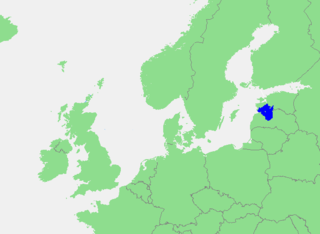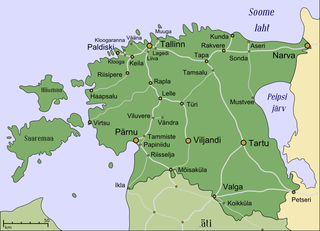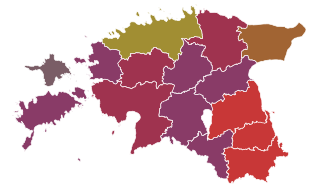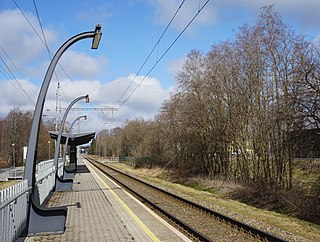
Saaremaa is the largest island in Estonia, measuring 2,673 km2 (1,032 sq mi). The main island of Saare County, it is located in the Baltic Sea, south of Hiiumaa island and west of Muhu island, and belongs to the West Estonian Archipelago. The capital of the island is Kuressaare, which in January 2018 had 13,276 inhabitants. The whole island had a recorded population in January 2020 of 31,435.

Hiiumaa is the second largest island in Estonia and is part of the West Estonian archipelago, in the Baltic Sea. It has an area of 989 km2 and is 22 km from the Estonian mainland. Its largest town is Kärdla. It is located within Hiiu County.

Aegna is an Estonian island in the Bay of Tallinn in the Baltic Sea. Administratively it is part of the city of Tallinn, the capital of Estonia and is a sub district of the Kesklinn district.

Saare County is one of 15 counties of Estonia. It consists of Saaremaa, the largest island of Estonia, and several smaller islands near it, most notably Muhu, Ruhnu, Abruka and Vilsandi. The county borders Lääne County to the east, Hiiu County to the north, and Latvia to the south. In 2022 Saare County had a population of 31,292, which was 2.4% of the population of Estonia.

The Gulf of Riga, Bay of Riga, or Gulf of Livonia is a bay of the Baltic Sea between Latvia and Estonia.

Ruhnu is an Estonian island in the Gulf of Riga in the Baltic Sea. It is administratively part of Saare County but is geographically closer to the Latvian mainland. At 11.9 square kilometres (4.6 sq mi), it has currently fewer than 100, mostly ethnic Estonian, permanent inhabitants. Ruhnu Parish has the smallest population of Estonia's 79 municipalities. Before 1944, it was for centuries populated by ethnic Swedes and traditional Swedish law was used.

Tallinna Linnatranspordi AS (TLT) is a transportation company owned by the city of Tallinn, Estonia. TLT is a result of the merger of Tallinn Bus Company and Tallinn Tram and Trolleybus Company in July 2012. The company provides bus, trolleybus, and tram services in Tallinn.

Kihnu is an island in the Baltic Sea. With an area of 16.4 km2 (6.3 sq mi) it is the largest island in the Gulf of Riga and the seventh largest island of Estonia. The length of the island is 7 km (4.3 mi) and width 3.3 km (2.1 mi), the highest point is at 8.9 metres (29.2 ft) above sea level.

Ruhnu Parish is a municipality in Saare County, Estonia. It encompasses the island of Ruhnu in the Gulf of Riga, together with a number of uninhabited islets. Its population is the smallest of any of Estonia's 79 municipalities, the parish being exempt from the usual minimum population size of 5000. There are 60 permanent inhabitants during winter time; in summer the number increases to 150. In 2015 the parish council approved Ado Tuuga's designs for the municipality's flag and coat of arms.

Pärnu Airport is an airport in Estonia. The airport is situated 2.4 nautical miles northwest of Pärnu.

The rail transport system in Estonia consists of about 1,200 kilometres (750 mi) of railway lines, of which 900 kilometres (560 mi) are currently in public use. The infrastructure of the railway network is mostly owned by the state and is regulated and surveyed by the Estonian Technical Surveillance Authority.
Manilaid is a 1.87 km2 (0.72 sq mi) Estonian islet in the Gulf of Riga, located between the island of Kihnu and the mainland's Tõstamaa peninsula. Together with the neighbouring smaller uninhabited islets Sorgu and Annilaid, Manilaid forms the village of Manija. Administratively the village belongs to Tõstamaa Parish in Pärnu County.
The Tallinn offensive was a strategic offensive by the Red Army's 2nd Shock and 8th armies and the Baltic Fleet against the German Army Detachment Narwa and Estonian units in mainland Estonia on the Eastern Front of World War II on 17–26 September 1944. Its German counterpart was the abandonment of the Estonian territory in a retreat codenamed Operation Aster.

Public transport in Tallinn consists of bus, tram, trolleybus, train and ferry services. Bus, tram and trolleybus routes are mainly operated by Tallinna Linnatranspordi AS. Electric train services are offered by Elron and the ferry service to Aegna island is operated by Kihnu Veeteed.

The history of rail transport in Estonia starts in 1870 when a line was opened connecting Paldiski, Tallinn, Tapa and Narva; the line extending all the way to St. Petersburg in Russia.

Kitseküla is a subdistrict of the district of Kesklinn (Midtown) in Tallinn, the capital of Estonia. It has a population of 4,053.

The Tallinn tram network is the only tram network in Estonia. Together with the four-route trolleybus network (et), the four tram lines, with a total length of 19.7 km arranged in a roughly cross-shaped layout, provide a backbone for the public transport network in the Estonian capital. All the routes meet up at Hobujaama in the city centre. Trams are unidirectional, one-sided and single-person operated, and much of the network runs on segregated track.

TS Laevad is an Estonian ferry company which operates two routes between the Estonian mainland and the islands of Hiiumaa and Muhu in the Baltic Sea. Muhu is connected by a causeway to Estonia's largest island, Saaremaa.

The COVID-19 pandemic in Estonia is part of the ongoing worldwide pandemic of coronavirus disease 2019 caused by severe acute respiratory syndrome coronavirus 2.

Laagri railway station is a station in the Nõmme district of Tallinn, Estonia. The railway station serves the Laagri sub-district of Nõmme and Laagri borough of Saue parish which in combination has approximately 6400 residents.



















